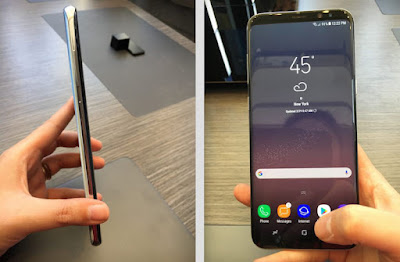Samsung's new Galaxy S8 (and its bigger sibling, the Galaxy
S8+) are designed to reintroduce the general public to Samsung as the company
tries to put the fiery death of the Galaxy Note several behind it.
And, as first impressions go, this is a doozy. In the event
Samsung is trying to wow us into relying it again, it's done a pretty realistic
alternative with this highly-polished, distinctive couple of devices.
The effect is surprisingly impressive. Presented that
Samsung has already established a similar edge-to-edge design on the Galaxy S7
Advantage for a couple of years now, I was not expecting to be thankful for a
little more room. But kicking out the home button does make a noticeable
difference phoning around - giving you more screen on which to surf, work and
watch videos.
The change will give both the Galaxy S8 and Galaxy S8+ a
slightly weird display screen size - they feel just somewhat too extra tall for
their width - that may be infuriating to view video on over time. The Galaxy S8
has a 5. 8-inch screen, even though the Galaxy S8+ has a 6. 2-inch screen.
Regardless of the odd condition, both models provide a lot of screen for a
phone that we can use conveniently with a singke hand. That's not something I
could say of the Galaxy Notice 7, which had a 5. 7-inch screen. We can't even
really say that of the 5. 5-inch iPhone 7 In addition to.
I thought the online buttons might throw myself off as well,
given my experience with similar designs in the former. But Samsung seems to
have done a realistic alternative in making sure the button is always
accessible, at least from what We saw.
- Size: 159.5 x 73.1 x 8.1mm
- Weight: 173g
- 6.2-inch Infinity Super AMOLED curved display with 2960 x 1440 resolution (529 PPI)
- Qualcomm Snapdragon 835 processor or Exynos 8895 8895 processor, depending on market
- 4GB of RAM, 6GB of RAM in China
- 64GB ofUFS 2.1 storage, 128GB ofUFS 2.1 storage in China
- microSD support up to 256GB
- 12-megapixel F/1.7 camera with autofocus and optical image stabilization, Quick Launch and Bixby support
- 8-megapixel F/1.7 front camera with autofocus, Quick Launch, and Bixby support
- Iris scanner
- Fingerprint sensor
- Heart rate sensor
- IP68 water and dust proof certification
- Bluetooth 5.0
- Wi-Fi 802.11 a/b/g/n/ac with dual band support
- GPS, Glonass
- USB Type-C
- 3.5mm headphone jack
- 3,500 mAh battery with fast-charging, wireless charging, and battery saving modes
- Android 7.0 Nougat with Samsung UX on top
Galaxy S8
- Size: 148.9 x 68.1 x 8mm
- Weight: 152g
- 5.8-inch Infinity Super AMOLED curved display with 2960 x 1440 resolution (571 PPI)
- Qualcomm Snapdragon 835 processor or Exynos 8895 8895 processor, depending on market
- 4GB of RAM, 6GB of RAM in China
- 64GB of UFS 2.1 storage, 128GB of UFS 2.1 storage in China
- microSD support up to 256GB
- 12-megapixel F/1.7 camera with autofocus and optical image stabilization, Quick Launch and Bixby support
- 8-megapixel F/1.7 front camera with autofocus, Quick Launch, and Bixby support
- Iris scanner
- Fingerprint sensor
- Heart rate sensor
- IP68 water and dust proof certification
- Bluetooth 5.0
- Wi-Fi 802.11 a/b/g/n/ac with dual band support
- GPS, Glonass
- USB Type-C
- 3.5mm headphone jack
- 3,000 mAh battery with fast-charging, wireless charging, and battery saving modes
- Android 7.0 Nougat with Samsung UX on top
The product is also very fast and feels powerful. I spent a
little time with Samsung DeX, the desktop mode that allows you to select your
phone into a monitor and special boat dock (sold separately for roughly $160),
which was also impressive at first dry. Samsung's secured full support for
Microsoft Office for the mode, making it feel about as capable as a netbook -
the one that also shows you your text, call and other notifications. You can
couple a Bluetooth keyboard and mouse to the DeX dock, or opt to plug one in,
so that you can use all the same keyboard commands if you're used to, as well
as the option to drag and drop.
And there are also some things that Samsung has promised
that I'll need to try for a while before I move final judgment. For example, I
didn't get any real sense of how effective Bixby, the provider's new voice
assistant, worked well in conversation - demo halls are notoriously loud. The
features I did so see, including its ability to search online for product just
by snapping a picture of something, were still in tightly handled demonstration
mode.
That's a pretty important feature to try before figuring
away on whether this is a phone I'd recommend over, say, Apple's i phone.
Because while the new screen design is nice - and it is, it should be said
again, very pretty - a bit high price for people over the edge
in order to drop $700 or $800 on a phone.




